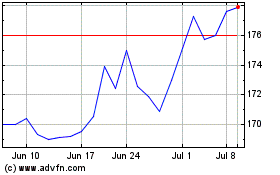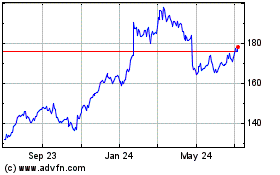IBM
Job Cuts Continue As Revenue Declines
International Business Machines Corp. this week quietly laid off
employees, continuing a wave of job cuts the company announced in
April.
IBM declined to say how many jobs would be cut overall. The
total layoffs could affect more than 14,000 jobs, according to an
estimate by Sanford Bernstein analyst Toni Sacconaghi.
The job cuts come after four straight years of declining revenue
as the rise of cloud computing threatens the company's software and
services business. IBM has said it would restructure its workforce
to retool for cloud services and data analysis, and could hire an
equal number of new employees by the end of the year.
The company said on Friday it had more than 20,000 open
positions. Two employees reached Friday said that IBM's internal
job-search tool listed between 7,000 and 8,000 open positions.
IBM's previous round of layoffs, which affected fewer than 5,000
employees, came in March. The company's workforce totaled 377,757
at the end of 2015.
"Their initiatives aren't going as fast as they'd like them to
and it's affecting their revenue more than they thought," said one
IBM employee affected by this week's layoffs who requested
anonymity because the employee is still with the company.
The latest cuts affected workers in the Research Triangle of
North Carolina; New York City; Poughkeepsie, N.Y.; and Boulder,
Colo. Some positions are being moved to places like India and Costa
Rica, according to workers affected by this week's cuts.
Earlier in the week, IBM said it would close its 70-acre Somers,
N.Y., campus and move those jobs to a facility in North Castle, New
York.
--Robert McMillan
Hapag-Lloyd
Merger Talks Move Toward Agreement
LONDON -- Merger talks between German container-shipping
operator Hapag-Lloyd AG and Dubai-based rival United Arab Shipping
Co. are progressing, and the companies likely will combine by the
end of the summer, people involved in the matter said.
"It's a win-win situation and talks are ticking along quite
well," one of the people said. "Unless there is a last-minute snag,
we will have a marriage by August."
Hapag-Lloyd and UASC said in April they were in preliminary
talks based on valuations that would give Hapag shareholders 72%
ownership of any combined firm, and holders of UASC the rest. They
are currently the world's sixth- and 10th-biggest container
operators in terms of capacity, and a merged entity would rank
fifth globally.
"The combined company will be worth around $9 billion," the
second person said.
The talks come amid a wave of consolidation sweeping the
container-shipping industry, which is squeezed by overcapacity,
slowing global growth and plummeting freight rates. Amid those
turbulent waters, a number of big companies in recent years have
combined forces to cut costs and increase competitiveness.
At the same time, operators have been scrambling to form
alliances, broad operational partnerships that have allowed them to
cut costs without a full-blown merger or takeover.
Most of the world's top dozen operators are part of alliances,
the most recent of which includes Hapag-Lloyd and was completed
earlier this month. UASC and debt-ridden Korean line Hyundai
Merchant Marine Co. were the only two left out of the new
groupings.
Their exclusion raised questions about their ability to compete
effectively in the world's most lucrative ocean trade routes.
"UASC's choice is to pump billions to build up its own fleet and
network in a largely futile attempt to compete globally on its own,
become a regional Middle East carrier or merge with Hapag-Lloyd and
be part of the global alliance that the Germans lead," said Lars
Jensen, chief executive of Copenhagen-based SeaIntelligence
Consulting ApS. "UASC's holders have always wanted a global
presence, so the merger with Hapag-Lloyd is really the only
option."
UASC is owned by the governments of Qatar, Saudi Arabia, Kuwait
and the United Arab Emirates. Qatar and Saudi Arabia are the
biggest holders, with stakes of 51% and 35%, respectively.
The company will hold an extraordinary shareholders meeting on
June 2 to decide on the merger. One person said he expects
"unanimous backing of the merger plan."
In late 2014 Hapag-Lloyd merged its container operations with
Chilean carrier Compañía Sud Americana de Vapores SA. CSAV owns
31.4% of Hapag-Lloyd, with the German city of Hamburg and Kuehne
Maritime GmbH, a private maritime investment company, holding
around 20% each.
A merger would provide Hapag-Lloyd access to UASC's six
Triple-Es, the world's biggest container ships, which have become
the weapon of choice in an arms race among the world's major
operators. The ships, which can cost up to $150 million each, can
move more than 18,000 containers and are outfitted with efficient
engines that can save on fuel.
UASC primarily operates in the Asia-to-Europe trade route, and a
merger with Hapag would give it wider access to the trans-Atlantic
and trans-Pacific loops.
--Costas Paris
Alphabet
New Google Phone Delayed Two Years
Alphabet Inc.'s Google said it plans to start selling phones
with modular, replaceable parts next year, two years later than
initially planned.
The project, dubbed Ara, is an aggressive effort by Google to
upend the mobile industry by making smartphones' hardware almost as
customizable as their apps. The company on Friday showed how
different parts could be snapped on to the back of a phone,
including high-powered camera lenses, speakers, a glucometer for
diabetes patients or a holder for breath mints.
Ara has had a rocky history. The project began in 2013 under
phone maker Motorola, then owned by Google. It later moved into
Google's Advanced Technology and Projects group, a lab that aims to
bring futuristic technologies to market in two years.
In January 2015, the advanced-technology group said it would
launch the modular phone in Puerto Rico later that year. Seven
months later, the team scrapped those plans and extended the
project's two-year timeline. People familiar with the project said
at the time that the Ara team was struggling to get the phone from
a prototype to large-scale production.
A Google spokeswoman said Friday that after listening to
developers and consumers, the Ara team made changes to the phone,
including installing more technology in the device's base to clear
room for more modules.
On Friday at Google's annual programmers' conference, Google
executives said they had moved Ara into its own business unit and
plan to release the modular phones to developers later this year,
with a 2017 consumer launch.
"Ara is our vision for the future of phones," said Dan Kaufman,
who took over the advanced-technology group last month after former
Pentagon research chief Regina Dugan left for Facebook Inc.
The Ara device will run on Google's Android mobile-operating
system. Google could make the base phone itself or work with a
hardware partner, as it does with its Nexus smartphones, Google
hardware chief Rick Osterloh said in an interview.
The Google spokeswoman said Friday that it was too early to
estimate a price for the phone. Google said last year that the
phone base would cost $50 at the outset.
Google likely will make some phone modules, Mr. Osterloh said,
but wants outsiders to develop new components. Google said Friday
it was working with several companies on modules, including
electronics makers Samsung Electronics Co., Sony Corp. and
Panasonic Corp.
Sony said its Sony Pictures Home Entertainment unit would
license content for the phone, not develop hardware. Samsung and
Panasonic didn't immediately respond to requests for comment.
In an onstage demonstration, a Google engineer attached a camera
to a phone and then took a photo of the audience. The event's
biggest applause came when he said "OK, Google, eject the camera,"
and the module popped out.
Google also gave updates on two other advanced-technology-group
projects: sensor-embedded clothing and a tiny radar sensor that
enables users to control devices via gestures.
Google and Levi Strauss & Co. unveiled a denim jacket with
touch sensors in its sleeve, set to be released next year. The
companies said the jacket is designed for bicyclists to control a
smartphone while riding.
A Levi executive changed a song with a swipe on his cuff, but
the functions appeared limited.
Google also showed off a concept LG Electronics Inc. watch with
a radar sensor inside, enabling an engineer on stage to scroll
through options on the watch with a twist of his fingers a few
inches from the device. The advantage of the gesture control over
using the watch's dial was unclear.
--Jack Nicas
(END) Dow Jones Newswires
May 23, 2016 02:48 ET (06:48 GMT)
Copyright (c) 2016 Dow Jones & Company, Inc.
International Business M... (NYSE:IBM)
Historical Stock Chart
From Mar 2024 to Apr 2024

International Business M... (NYSE:IBM)
Historical Stock Chart
From Apr 2023 to Apr 2024
